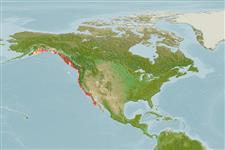>
Perciformes/Scorpaenoidei (Scorpionfishes) >
Sebastidae (Rockfishes, rockcods and thornyheads) > Sebastinae
Etymology: Sebastes: Greek, sebastes = august, venerable (Ref. 45335); auriculatus: From the Latin auriculatus, meaning 'eared' (Ref. 27436).
More on author: Girard.
Environment: milieu / climate zone / depth range / distribution range
Ecologia
marinhas demersal; intervalo de profundidade 0 - 128 m (Ref. 27437). Temperate; ? - 15°C (Ref. 131058); 62°N - 27°N, 155°W - 113°W
Eastern Pacific: Prince William Sound, Alaska to central Baja California, Mexico.
Comprimento de primeira maturação / Tamanho / Peso / Idade
Maturity: Lm 31.0, range 26 - 38 cm
Max length : 56.0 cm TL macho/indeterminado; (Ref. 27437); idade máx. registrada: 34 anos (Ref. 56049)
Descrição suscinta
Chaves de identificação | Morfologia | Morfometria
Espinhos dorsais (total) : 13; Raios dorsais (total) : 12 - 15; Espinhos anais: 3; Raios anais : 5 - 8; Vértebras: 26 - 27. Head spines strong - nasal, preocular, postocular, tympanic, coronal (may be absent), parietal, and nuchal (may be absent) spines present, supraoculars absent (Ref. 27437). Interorbital space flat to barely convex; symphyseal knob weak or absent (Ref. 27437). Caudal fin rounded (Ref. 6885). Light brown, mottled with one or two shades of darker brown, vague dark bars dorsally, dark brown blotch on upper part of gill cover; fins and underside of throat and lower jaw pinkish (Ref. 27437). Branchiostegal rays: 7 (Ref. 36715).
A sedentary rockfish found in shallow water and bays (Ref. 2850), among sheltering weed-covered rocks or around pilings (Ref. 27436). Viviparous, with planktonic larvae and pelagic juveniles (Ref. 36715). Fin spines are sharp and mildly venomous and can cause annoying wounds (Ref. 27436). Small live specimens make excellent bait for large lingcod (Ref. 27436). Flesh is firm and tasty, but rarely found in markets (Ref. 26346).
Eschmeyer, W.N., E.S. Herald and H. Hammann, 1983. A field guide to Pacific coast fishes of North America. Boston (MA, USA): Houghton Mifflin Company. xii+336 p. (Ref. 2850)
Status na Lista Vermelha da UICN (Ref. 130435: Version 2024-1)
Uso pelos humanos
Pescarias: pouco comercial; peixe esportivo: sim; Aquário: Aquários públicos; isca: occasionally
Ferramentas
Relatórios especiais
Baixar XML
Fontes da internet
Estimates based on models
Preferred temperature (Ref.
123201): 8 - 12.8, mean 9.7 °C (based on 80 cells).
Índice de diversidade filogenética (Ref.
82804): PD
50 = 0.5000 [Uniqueness, from 0.5 = low to 2.0 = high].
Bayesian length-weight: a=0.01000 (0.00495 - 0.02022), b=3.09 (2.92 - 3.26), in cm total length, based on LWR estimates for this Genus-body shape (Ref.
93245).
Nível Trófico (Ref.
69278): 4.0 ±0.62 se; based on food items.
Resiliência (Ref.
120179): Baixo, tempo mínimo de duplicação da população 4,5 - 14 anos (tmax=34; tm=5).
Prior r = 0.19, 95% CL = 0.13 - 0.29, Based on 2 full stock assessments.
Fishing Vulnerability (Ref.
59153): Moderate vulnerability (42 of 100).
Nutrients (Ref.
124155): Calcium = 23.4 [8.7, 72.9] mg/100g; Iron = 0.241 [0.100, 0.565] mg/100g; Protein = 18.2 [17.0, 19.3] %; Omega3 = 1.14 [0.47, 2.78] g/100g; Selenium = 31.1 [12.4, 94.1] μg/100g; VitaminA = 24.2 [7.7, 76.5] μg/100g; Zinc = 0.356 [0.189, 0.635] mg/100g (wet weight);
